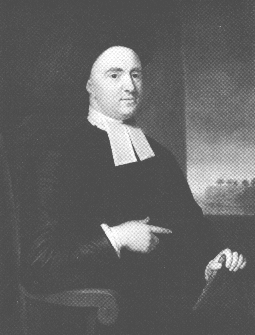
In 1734, (Irish) George Berkeley, (1685-1743), Bishop of Cloyne, wrote a memoir, The Analyst, attacking Newton's version of "the calculus" (known as "fluxions"). Mathematical historian, Florian Cajori, has called publication of this memoir "the most spectacular event of that century in the history of mathematics". For this devastating criticism provoked "the Second Crisis in The Foundations of Mathematics". (Its eventual resolution in the 19th century, gave firm support to "the calculus", bringing about our present Civilization.)
WHY BISHOP BARKELEY ATTACKED ISAAC NEWTONBerkeley was called to witness the last rites of a dying parishioner. But when he arrived, the person refused his offices because his friend, Edmund Halley (the astronomer), had convinced him that "Newton proved no need for God". Allegedly, Newton's mathematical model would explain "it all" and "keep it going".
Berkely was so annoyed at this that he decided to look into Newton's work. He found a glaring error in Newton's development of "the differential calculus", used to explain our Solar System.
In "passing to a limit" to obtain "the derivative operator", Newton used a result which was equivalent to DIVIDING BY ZERO.
You can see the practical effect of this, on a calculator, if you put in a DIVIDEND, then hit the "divide button" without inputing a DIVISOR -- hence, DIVIDING BY ZERO. Be ready to turn off the calculator, since it will go on and on until it breaks down!
Theoretically, you can see the problem in the following.
You know that MULTIPLYING ANY NUMBER BY ZERO YIELDS A ZERO PRODUCT. Thus, 0 x 1 = 0. And 0 x 2 = 0. So far, correct.
And "things equal to the same thing are equal to each other". So, 0 X 1 = 0 = 0 X 2, or 0 X 1 = 0 X 2. Still, correct.
Now for the SNAPPER. You've heard that "equals divided by equals yields equals". Well, this equation has 0 on both sides, so let's "divide it out". Aha! 1 = 2.
But this could lead to ADDING 1 on both sides of the equation1 + 1 = 1 + 2 or 2 = 3. And, IN GENERAL, you can than MAKE EVERY NUMBER EQUAL EVERY OTHER NUMBER. You DESTROY ARITHMETIC -- or RENDER IT USEFLESS!
Whahappened? That statement about DIVIDING is INCORRECT BECAUSE IT IS INCOMPLETE. IT SHOULD READ "equals divided by NONZERO-equals yields equals"!!!!!
Over and over, in MATH, BEFORE YOU DIVIDE, you must ENSURE THAT YOU ARE NOT DIVIDING BY ZERO!
That is built into THE DIVISION ALGORITHM ("behind long division"). It reads:
DIVISION ALGORITH: Given DIVIDEND, D; DIVISOR, d; QUOTIENT, Q; REMAINDER, D. Then D = d x Q + R, where 0 £ R < d.This form has THREE NECESSARY CONDITION:
- By BOUNDING the DIVISOR, d, away from 0, it PRECLUDES DIVISION BY ZERO.
- By making the REMAINDER, R, LESS THAN THE DIVISOR, d, it CREATES A PROCESS OF DECREASING RESULTS.
- By BOUNDING the REMAINDER, R, by 0, it ARRANGES THAT THE DIVIDING WILL STOP.
I think the DIVIDING BY ZERO should now be understood, but I'll explain the last CONDITION.
The REMAINDER should "never go negative"! Why? Because DIVISION is EQUIVALENT TO REPEATED SUBTRACTION. If this process is BOUNDED BY ZERO, it will END. But, if allowed to go "below zero", IT WOULD NEVER END!
Getting back to Berkley. It's believed that Berkley was the first person to draw attention to THE FALLCY OF DIVIDING BY ZERO.
George Berkley became famous as a PHILOSOPHER. In 1728, Berkeley came to America and spent 3 years in Rhode Island. Later, back in Ireland, Berkeley wrote a poem (still included in some anthologies), "On the Prospect of Planting Arts and Learning in America", whose last stanza begins with a line often quoted by orators and politicians:
Westward the course of empire takes its way; The first four acts already past, A fifth shall close the drama with the day; Time's noblest offspring is the last.Because of this work, the town of Berkeley, California, was named after this man, as well as The University of California at Berkeley.